Women in Iran
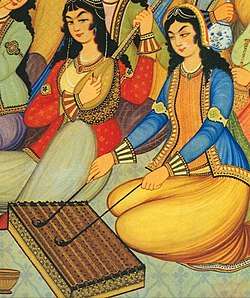 Women playing santur (fragment of painting "Musical gathering" by Ibrahim Jabbar-Beik (1923-2002)). | |
| Gender Inequality Index | |
|---|---|
| Value | 0.496 (2012) |
| Rank | 107th |
| Maternal mortality (per 100,000) | 21 (2010) |
| Women in parliament | 6% (2016) |
| Females over 25 with secondary education | 62.1% (2010) |
| Women in labour force | 49% (2011) |
| Global Gender Gap Index[1] | |
| Value | 0.5842 (2013) |
| Rank | 130th out of 144 |
Women in Iran discusses the history, contribution, aspects, and roles of women in Iran. Women have always played fundamental, crucial, and representative roles in the long history of Iran.
History
Ancient Iran
Archeological excavations at Shahr-e Sookhteh "Burnt City," a prehistoric settlement in the Sistan-Baluchistan province of southeastern Iran, have revealed that the women of the 4th–3rd millennium BCE community maintained a high level of socio-economic status. Of the seals discovered in graves there, 90% were in the possession of women,[2] who in turn made up over 60% of the population.[3] The distribution of the seals, which as instruments of trade and government represented economic and administrative control, reveals that these women were the more powerful group in their prehistoric society.[2]
The early Achaemenid-era Persepolis fortification and treasury tablets refers to women in three different terms: mutu, irti and duksis.[4] The first refers to ordinary (non-royal) women; the second to unmarried members of the royal family; and the last duksis to married women of royalty. Such differentiated terminology shows the significance of marital status and of a woman's relationship to the king. The tablets also reveal that women of the royal household traveled extensively and often personally administered their own estates.[4] The queen and her ladies-in-waiting are known to have played polo against the emperor and his courtiers.[5] The only limits on the extent of the authority exercised by the king's mother were set by the monarch himself.[6]
In the tablets, "non-royals and the ordinary workers are mentioned by their rank in the specific work group or workshops they were employed. The rations they received are based on skill and the level of responsibility they assumed in the workplace. The professions are divided by gender and listed according to the amount of ration. Records indicate that some professions were undertaken by both sexes while others were restricted to either male or female workers. There are male and female supervisors at the mixed workshops as evident by the higher rations they have received with little difference in the amount of rations between the two sexes. There are also occasions where women listed in the same category as men received less rations and vice versa. Female managers have different titles presumably reflecting their level of skill and rank. The highest-ranking female workers in the texts are called arashshara (great chief). They appear repeatedly in the texts, were employed at different locations and managed large groups of women, children and sometimes men working in their units. They usually receive high rations of wine and grains exceeding all the other workers in the unit including the males."[4] Pregnant women also received higher rations than others. Women with new-born children also received extra rations for a period of one month.
A few experts say that it was Cyrus the Great who twelve centuries before Islam, established the custom of covering women to protect their chastity. According to their theory, the veil passed from the Achaemenids to the Hellenistic Seleucids. They, in turn, handed it to the Byzantines, from whom the Arab conquerors inherited it as hijab, transmitting it over the vast reaches of the Muslim world.[7]
The Sassanid princess Purandokht, daughter of Khosrau II, ruled the Persian empire for almost two years before resigning. Also, during the Sassanian dynasty many of the Iranian soldiers who were captured by Romans were women who were fighting along with the men.[8]
Persian women are depicted in many masterpieces of Persian miniatures.[9] These are often used as sources to "trace through the sequence of women's fashion from earlier periods".[10]
At the Battle of Ctesiphon (363) the victorious Roman soldiers prized young Persian women, seizing them as war booty.[11]
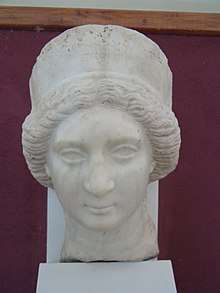
- The Persian lady portrayed in five medallions on this bowl has a hairstyle that suggests that she may have been a queen in the Sassanid royal family at the time of King Narseh.
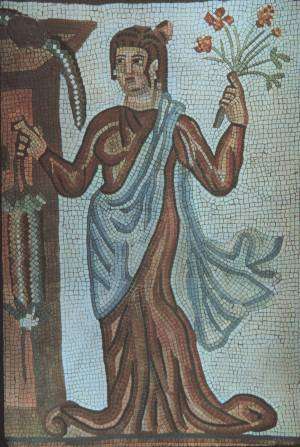
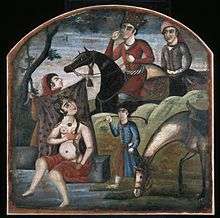 Khusraw Discovers Shirin Bathing, from Pictorial Cycle of Eight Poetic Subjects, mid-18th century; Brooklyn Museum
Khusraw Discovers Shirin Bathing, from Pictorial Cycle of Eight Poetic Subjects, mid-18th century; Brooklyn Museum
Islamic periods
Qajar Dynasty
During the Qajar dynasty (1789–1925), Malek Jahan Khanom as queen mother exerted serious political influence during the reign of her son, from 1848 until her death in 1873.
Pahlavi Dynasty
The Pahlavi Shahs were the rulers of Iran between 1925 and 1979 and they introduced many reforms concerning women's rights. An example of an early reform introduced by Reza Shah was the 'forced unveiling of women by a special decree on January 8, 1936 which, as the name suggests, involved the police force pulling the hijab away even from religious women, by force.'[12] Women's involvement in society in general increased. Iranian women increasingly participated in the economy, the educations sector and in the workforce. Levels of literacy were also improved. Examples of women's involvement: women acquired high official positions, such as ministers, artists, judges, scientists, athletes, etc.
Under Reza Shah's successor Mohammad Reza Shah many more significant reforms were introduced. For example, in 1963, the Shah granted female suffrage and soon after women were elected to the Majlis (the parliament) and the upper house, and appointed as judges and ministers in the cabinet.'.[12] In 1967 Iranian family law was also reformed which improved the position of women in Iranian society. It was included in the civil code and was designed to protect wives, children and female divorcees. The general thrust of the reforms were to promote equality between men and women in society.
The Family Protection Laws of 1967 and 1973 required a husband to go to court to divorce rather than simply proclaim the triple talaq of "I divorce thee" three times, as stipulated by traditional sharia law. It allowed a wife to initiate divorce and required the first wife's permission for a husband to take a second wife. Child custody was left to new family protection courts rather than automatically granted to the father. The minimum age at which a female could marry was raised from 13 to 15 in 1967 and to 18 in 1975.[13]
Islamic Republic of Iran

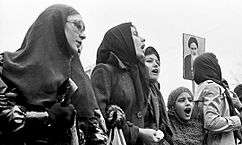
Following the 1979 Iranian Revolution Iran became an Islamic Republic. During the era of post-Revolution rule, Iranian women have had more opportunities in some areas and more restrictions in others. One of the striking features of the revolution was the large scale participation of women from traditional backgrounds in demonstrations leading up to the overthrow of the monarchy. The Iranian women who had gained confidence and higher education under Pahlavi era participated in demonstrations against Shah to topple monarchy. The culture of education for women was established by the time of revolution so that even after the revolution, large numbers of women entered the civil service and higher education,[16] and, in 1996. 14 women were elected to the Islamic Consultative Assembly.
Ayatollah Khomeini seemed to express appreciation for women's issues after he took power. In May 1979, Khomeini addressed his audience and spoke about Fatimah: "After the death of her father, Fatimah (peace be upon her), lived for seventy-five days. She was in this world, overcome with sadness and grief. Gabriel, the Trusted Spirit, came to visit and console her and tell her of future events." So, according to this tradition, in these seventy-five days that she had contact with Gabriel, he came and went many times. I do not believe that anyone else except the great prophets have had such an experience, in which for seventy-five days Gabriel, the Trusted Spirit, came and went and spoke of things that would take place in the future, that would happen to her ancestors in the future."[17] The Ayatollah spoke fondly of Fatimah as a role model for women. He said that even though she was visited by the Angel Gabriel, this is not what made her special. To him, her admirable qualities were twofold and supposedly represented by the visits from Gabriel: her special spiritual status and her excellent moral character. He continued to explain that Fatimah could have been born with this spiritual status or Fatimah could have gone through a kind of unique mystical experience. This is why the Ayatollah believed she represented the ideal female role model. Fatimah's moral excellence is observed in three interconnected activities: struggle, inspiring men, and suffering.[18] Fatimah inspired her husband as a devout Muslim. Khomeini draws parallels to this inspiration with women of Iran and how they should strive to follow their religious calling like Fatimah.
| Comparison | ||
|---|---|---|
| 42.33% | Literacy (15-24)[19] | 97.70% |
| 24.42% | Literacy (>15)[19] | 79.23% |
| 48,845 | Students[20] | 2,191,409 |
| 122,753 | Graduates[21] | 5,023,992 |
| 2.4% | Graduates (%)[21] | 18.4% |
| 19.7 | Age at 1st marriage[22] | 23.4 |
By 1999, Iran had 140 female publishers, enough to hold an exhibition of books and magazines published by women.[23] As of 2005, 65 percent of Iran's university students and 43 percent of its salaried workers were women.[24] As of early 2007, nearly 70 percent of Iran's science and engineering students are women.[25]
27.1% female ministers in government put Iran among first 23 countries in early 2000s,[26] 2.8-4.9% female parliamentarians in past 15 years put it among least 25 countries.[27] In 2009 Fatemeh Bodaghi became Vice President for Legal Affairs and a top advisor to President Mahmoud Ahmedinejad.[28] Maryam Mojtahidzadeh who runs the women's ministry was also selected as an advisor to the president.[29]
At least one observer (Robert D. Kaplan) has commented on the less traditional attitude of many women in Iran compared to other Middle Eastern countries. "In Iran, you could point a camera at a woman... and she would smile" in contrast to other more conservative places where women may mind this.[30]
There are also women in the Iranian police who deal with crimes committed by women and children.[31][32] According to opinion of Supreme Leader of Iran, Ali Khamenei, giving opportunity for develop woman's talents in the family and society is respecting to the woman.[33]
Politics
| Body | Seats |
|---|---|
| Cabinet | 2 / 31(6%) |
| Parliament | 17 / 290(6%) |
| Assembly of Experts | 0 / 88(0%) |
| Guardian Council | 0 / 12(0%) |
| Expediency Council | 0 / 39(0%) |
| City Councils | |
| Tehran | 6 / 21(29%) |
| Mashhad | 2 / 15(13%) |
| Isfahan | 2 / 13(15%) |
| Shiraz | 2 / 13(15%) |
| Tabriz | 1 / 13(8%) |
Women in Iran were granted the right to vote in 1963.[34] They were first admitted to Iranian universities in 1937.[35] Since then, several women have held high-ranking posts in the government or parliament. Before and after the 1979 revolution, several women were appointed ministers or ambassadors. Farrokhroo Parsa was the first woman to be appointed Minister of Education in 1968 and Mahnaz Afkhami was appointed Minister for Women's Affairs in 1976.
Some, such as Tahereh Saffarzadeh, Masumeh Ebtekar, Azam Taleghani, Fatemeh Haghighatjou, Elaheh Koulaei, Fatemeh Javadi, Marzieh Dabbaq and Zahra Rahnavard came after the revolution. Other Iranian women, including Goli Ameri and Farah Karimi hold positions in Western countries.
There are currently 17 women in parliament, of a total of 290 parliamentarians.[36] This was up from nine in the previous elections.
Currently there are several all-female political organizations active in Iran, including:
| Party | Secretary-General | Camp |
|---|---|---|
| Zeynab Society | Azam Haji-Abbasi[37] | Principlist |
| Association of the Women of the Islamic Revolution | Sedigheh Hejazi[38] | Principlist |
| Islamic Assembly of Ladies | Fatemeh Karroubi | Reformist |
| Association of the Women of the Islamic Republic | Zahra Mostafavi Khomeini | Reformist |
| Women Journalists Association | Jaleh Faramarzian[39] | Reformist |
| Reformist Women's Party | Zahra Shojaei[40] | Reformist |
| Society of Progressive Muslim Women | Fatemeh Rakeei[41] | Reformist |
| Women's Society of the Islamic Revolution | Azam Taleghani[42] | Reformist |
| Society for Support of Women's Rights | Shahindokht Molaverdi[43] | Reformist |
Education
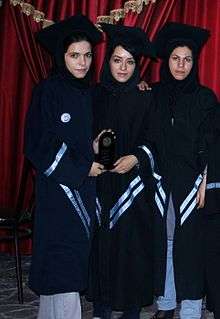
Formal education for women in Iran began in 1907 with the establishment of the first primary school for girls.[45] Education held an important role in Iranian society, especially as the nation began a period of modernization under the authority of Reza Shah Pahlavi in the early 20th century when the number of women's schools began to grow. By mid-century, legal reforms granting women the right to vote and raising the minimum age for marriage offered more opportunities for women to pursue education outside the home.[45] After periods of imposed restrictions, women's educational attainment continued its rise through the Islamification of education following the Iranian Revolution of 1979, peaking in the years following radical changes in the curriculum and composition of classrooms.[46] By 1989, women dominated the entrance examinations for college attendance.[47]
Women's participation in education has not slowed despite efforts to impose restrictions on the increasingly female-dominated educational sphere. The changes in women's education have split into increased usage and dominance of the opportunities available to women, and the imposition of strict requirements governing their role in education, including gender-segregated classes, Islamic dress, and the channeling of women into "feminine" majors that prevent the pursuit of certain careers.[46]
Illiteracy among women has been on a decrease since 1970 when it was 54 percent to the year 2000 when it was 17.30 percent.[48] Iranian female education went from a 46 percent literacy rate, to 83 percent.[48] Iran ranked 10th in terms of female literacy in the 1970s, and still holds this position today.[49]
According to UNESCO world survey, at primary level of enrollment Iran has the highest female to male ratio in the world among sovereign nations, with a girl to boy ratio of 1.22 : 1.00.[50] According to UNESCO data from 2012, Iran has more female students in engineering fields than any other country in the world.[44]
Role in economy

Since the 1970s Iran has experienced significant economic and social changes. Women's workforce participation rate went from 9.1 percent in 1996 to 14 percent in 2004 to 31.9 in 2009.[51][52] That is a 22.8 percent increase in 13 years. Women make up over half of the Iranian population, yet they make up a small percentage of the work force. Official statistics reported by the Census Bureau suggest that women's labor force participation remains quite low.[49] Women make up almost 30 percent of the Iranian labor force, and the percentage of all Iranian women who are economically active has more than doubled from 6.1 percent in 1986 to 13.7 percent in 2000.[53][54] In 2004, there were 18 million people employed in Iran, Women made up only 12.9 percent (or roughly 2,160,000) of the employed population. Men on the other hand made up 64 percent, or roughly 11,520,000.[55] The ILO data, however, suggest that female unemployment has been consistently higher than men's in recent years (Olmsted). Women are concentrated in the typically female jobs of teaching and caring. 82.7 percent of female civil servants work in teaching and education followed by administrative, financial, clerical, health and medical professions.[51] However, according to the International Labour Organization, the top three areas of female employment are agriculture, manufacturing, and education. A factor in the increase in women's employment is an increase in their literacy rates. The illiteracy among women has been on a decrease since 1970 when it was 54 percent to the year 2000 when it was 17.30 percent.[48] Iranian female education went form a 46 percent literacy rate, to 83 percent.[48] Iran ranked 10th in terms of female literacy in the 1970s, and still holds this position today.[49] Women's labor force participation rate and literacy rate has been on the rise. Yet the unemployment rate for women compared to that of men is still considerably higher. Take, for example, that in 1996, the unemployment rate for women was 13.4 percent whereas for men, the unemployment rate was 8.4 percent.[48] The unemployment rate for both men and women has increased since 1996, with the gender gap in unemployment still present. In 2008 for example, male unemployment was 9.1 percent and female was 16.7 percent[56]
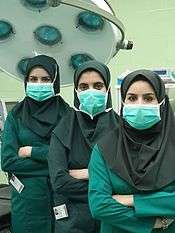
Studies concerning female labor force participation vary. One factor to this is the difference between measurements. The Iranian Census provides one measurement for labor force participation, and the Labor Force survey provides another.[49] The Iranian census for example, used different ages for the cut off age, 10 for the 1976 census, and used 6 for the 1986 census (Olmsted) While the International Labour Organization uses 15.[49] The World Bank and International Labour Organization have different data on recent female employment; the ILO reports an employment rate of 17.1 percent which is considerably higher than that of the World Bank.[49] Overall, there seems to be a common upward trend in employment over time.
Women in Iran had previously been restricted to the private sphere, which includes the care of the home and the children, they have been restricted from mobility, and they needed their husband's permission in order to obtain a job.[57] Employers depict women as less reliable in the workforce as opposed to men.[58] However, the Islamic Revolution had some influence in changing this perception.[59] Secular feminists and the elite were not happy with the revolution, while other feminists such as Roksana Bahramitash argue that the revolution did bring women into the public sphere.[59] The 1979 Revolution had gained widespread support from women who were eager to earn rights for themselves. A woman's responsibility and obligation was in the home, which was the underlying basis of the Islamic Republic.[51] Olmsted adds to this by stating that women have this "double burden."[49] In addition, men had the right to inhibit their wives from entering the labor force. Ali Akbar Mahdi is in agreement with Parvin Ghorayshi in that through the domestication of women and confinement to the private sphere, they were being exploited in non-wage activities.[60] In Karimi's viewpoint, after the revolution, even though it had been accepted on paper that women had an equal right to employment, she believed that this did not show in practice.[61] Comparing the pre-revolution and post-revolution era, between 1976 and 1986, the labor force participation of women had declined immensely from 12.9 percent down to 8.2 percent.[49] In addition, during the 1990s, women were being compensated for their housework due to the domestic wage law which allowed women to demand compensation from their husbands for their housework in the event of a divorce.[59]
.jpg)
In 1979 the United States imposed an economic boycott on Iran.[61] In particular, the boycott affected the carpet industry. As a result, the boycott influenced women's participation in the labor force.[49] Weaving is a common occupation for women, as it can be done inside the family home.[61] If the market is volatile, merchants can simply remove or add looms to the worker's home in response to demand. Therefore, women who have children to take care of can be inside the home while tending to their work.[61] Carpet weaving was very common among women from rural areas. Thus, carpet weaving was a valuable method of increasing the economic involvement of women in rural neighborhoods.[62] In 1996, over 91 percent of the female industrial employees were in the textile industry which consisted largely of carpet weaving.[61] Nonetheless, this all changed due to sanctions. Before the Islamic Revolution, Iranian firms were combined with firms in the United States where Iranians produced rugs for the United States market. However, due to the United States inflicting sanctions on Iran, Iranian imports were banned from the country. The demand for Iranian carpets was still high. In response, Americans bought carpets with Iranian designs from other countries that produced the same carpets, such as China and India.[61] Again, from 1994 to 2005 the export of carpets had declined drastically. In 1994 they were selling over $2 million worth of carpets and then in 2005 it went down to under $500 in carpet exports. In other words, the total share of carpet in non-oil exports had declined from 44.2 percent to 4.2 percent; a drastic decrease.[49] Olmsted concurs with Moghadam this would drastically affect women in the labor market, since the majority of carpet weavers consisted of less educated women.[49][57]
Entrepreneurship
According to the 2012 Global Entrepreneurship Monitor report, the rate of entrepreneurship in Iran for women between the ages 18 to 64 fluctuated from 4 to 6 percent between 2008 and 2012 while their overall economic participation makes up only 13 percent of the entire economy.[63][64]
Iranian women's movement
The movement for women's rights in Iran is particularly complex within the scope of the political history of the country. Women have consistently pushed boundaries of societal mores and were continually gaining more political and economic rights. Women heavily participated at every level of the revolution. Within months of the formation of the Islamic republic by Ruhollah Khomeini many important rights were repealed,[65] but in mid-1980s replaced by a far more protective laws.[66]
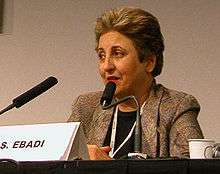
In 2003, Shirin Ebadi, Iran's first female judge in the Pahlavi era, won the Nobel Peace Prize for her efforts in promoting human rights.[67]
During the last few decades, Iranian women have had significant presence in Iran's scientific movement, art movement, literary new wave and the new wave of Iranian cinema. According to the research ministry of Iran, about 6 percent of full professors, 8 percent of associate professors, and 14 percent of assistant professors were women in the 1998–99 academic year. However, women accounted for 56 percent of all students in the natural sciences, including one in five PhD students.[68] In total 49.8 percent of the university students in Iran are women.[69]
With the 2005 election of President Mahmoud Ahmadinejad, Western media said that women's rights declined.[70][71][72] After Ahmadinejad's re-election in 2009, the first female minister was appointed.[73]
Iranian women's day
Every year, people in Iran commemorate the national Women's Day and Mother's Day on the 20 Jumada al-Thani, which marks the birthday anniversary of Fatima Zahra (often referred to as a role model), Muhammad's daughter and the wife of Imam Ali. Many Iranians take the occasion of this holiday to thank and honor their mothers, grandmothers, wives and sisters and to spend more time with them. They pay tribute to them by giving them gifts.[74]
Women's clothing
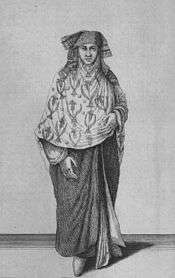
For many centuries, since ancient pre-Islamic times, female headscarf was a normative dress code in the Greater Iran. First veils in region are historically attested in ancient Mesopotamia as a complementary garment,[75] but later it became exclusionary and privileging in Assyria, even regulated by social law. Veil was a status symbol enjoyed by upper-class and royal women, while law prohibited peasant women, slaves and prostitutes from wearing the veil, and violators were punished.[66][75] After ancient Iranians conquered Assyrian Nineveh in 612 BC and Chaldean Babylon in 539 BC, their ruling elite has adopted those Mesopotamian customs.[75] During the reign of ancient Iranian dynasties, veil was first exclusive to the wealthy, but gradually the practice spread and it became standard for modesty.[76] Later, after the Muslim Arabs conquered Sassanid Iran, early Muslims adopted veiling as a result of their exposure to the strong Iranian cultural influence.[66][76][77][78][79]
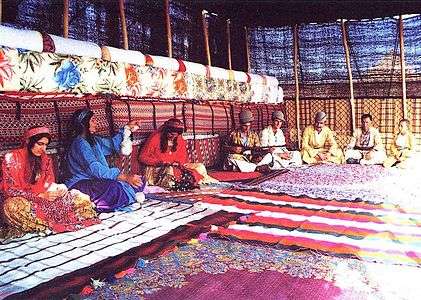
This general situation did change somewhat in the Middle Ages after arrival of the Turkic nomadic tribes from Central Asia, whose women didn’t wear headscarves.[79][80] However, after the Safavid centralization in the 16th century, the headscarf became defined as the standard head dress for the women in urban areas all around the Iranian Empire.[81] Exceptions to this standard were seen only in the villages and among the nomads, so women without a headscarf could be found only among rural people and nomadic tribes[79][80][82][83][84] (like Qashqai). Veiling of faces, that is, covering the hair and the whole face was very rare among the Iranians and was mostly restricted to the Arabs (niqab, battula and boushiya) and the Afghans (burqa). Later, during the economic crisis in the late 19th century under the Qajar dynasty, the poorest urban women could not afford headscarves due to the high price of textile and its scarcity.[82] Owing to the aforementioned historical circumstances, the covering of hair has always been the norm in Iranian dress, and removing it was considered impolite, or even an insult.[85] In the early 20th century, the Iranians associated not wearing it as something rural, nomadic, poor and non-Iranian.
Attempts at changing the dress code (and perspectives toward it) occurred in mid-1930s when pro-Western autocratic ruler Reza Shah issued an arbitrary decree, banning all veils abruptly, swiftly and forcefully.[66][85][86][87][88] Many types of male traditional clothing were also banned under the pretext that "Westerners now wouldn’t laugh at us".[89][90][91] Western historians state that this would have been a progressive step if women had indeed chosen to do it themselves, but instead this ban humiliated and alienated many Iranian women,[75][79][83][86] since its effect was comparable to the hypothetical situation in which the European women had suddenly been ordered to go out topless into the street.[75][89][90][91] To enforce this decree, the police was ordered to physically remove the veil off of any woman who wore it in public. Women were beaten, their headscarves and chadors torn off, and their homes forcibly searched.[66][75][83][85][86][89][90][91][92][93] Until Reza Shah's abdication in 1941, many women simply chose not leave their houses in order to avoid such embarrassing confrontations,[66][83][89][90][91] and a few even committed suicide.[89][90][91] Later, official measures relaxed slightly under next ruler and wearing of the headscarf or chador was no longer an offence, but for his regime it became a significant hindrance to climbing the social ladder as it was considered a badge of backwardness and an indicator of being a member of the lower class.[75] Discrimination against the women wearing the headscarf or chador was still widespread with public institutions actively discouraging their use, and some eating establishments refusing to admit women who wore them.[66][94]
.jpg)

A few years prior to the Iranian revolution, a tendency towards questioning the relevance of Eurocentric gender roles as the model for Iranian society gained much ground among university students, and this sentiment was manifested in street demonstrations where many women from the previously non-veiled middle classes put on the veil[66][75][85][95][96] and symbolically rejected the gender ideology of Pahlavi regime and its aggressive deculturalization.[66][75][85][86][96] Many argued that veiling should be restored to stop further dissolution of the Iranian identity and culture,[85] as from an Iranian point of view the unveiled women are seen as exploited by Western materialism and consumerism.[79][84][85][86] Wearing of headscarf and chador was one of main symbols of the revolution,[85][86][94][96] along with the resurgence and wearing of other traditional Iranian dresses. Headscarves and chadors were worn by all women as a religious and/or nationalistic symbols,[85][86][94][96] and even many secular and Westernized women, who did not believe in wearing them before the revolution, began wearing them, in solidarity with the more religious women who always wore them.[66][75][85][95][96] Wearing headscarves and chadors was used as a significant populist tool and Iranian veiled women played an important rule in the revolution's victory.[75][86][88] Since Islamic dress was made mandatory for women in 1984,[96] some Iranian women have attempted to come up with their own clothing styles within the confines of Islamic law. For example, a headscarf (rousari) combined with other colorful elements of clothing has become common, especially in urban areas.[79][93] Iranian authorities in Tehran have recently indicated that the punishment for failing to comply with the Islamic dress code will be made less harsh. Women will no longer be arrested for "improper hijab", but will instead be made to attend classes given by police.[97][98][99]
Women in Iranian culture
Persian literature
Over the past two centuries, women have played a prominent role in Persian literature. Contemporary Iranian poets include Simin Behbahani, Forough Farrokhzad, Parvin Etesami. Simin Behbahani has written passionate love poems as well as narrative poetry enriched by a motherly affection for all humans.[100] Behbahani is president of The Iranian Writers' Association and was nominated for the Nobel Prize in literature in 1997.
Contemporary authors include Simin Daneshvar, Mahshid Amirshahi, Shahrnush Pârsipur, Moniru Ravânipur and Zoya Pirzad to name a few. Daneshvar's work spans pre-Revolutionary and post-Revolutionary Iranian literature. Her first collection of short stories, Âtash-e khâmush (Fire Quenched), was published in 1948. It was the first collection of short stories published by a woman in Iran. In 1969, she published Savushun (Mourners of Siyâvash), a novel that reflected the Iranian experience of modernity during the 20th century. It was the first novel published by a woman in Iran. Daneshvar was the first president of the Iranian Writers' Association. Shahrnush Pârsipur became popular in the 1980s following the publication of her short stories. Her 1990 novel, Zanân bedûn-e Mardân (Women Without Men), addressed issues of sexuality and identity. It was banned by the Islamic Republic. Moniru Ravânipur's work includes a collection of short stories, Kanizu (The Female Slave), and her novel Ahl-e gharq (The People of Gharq). Ravânipur is known for her focus on rituals, customs and traditions of coastal life.[101]
Iranian music
Perhaps Qamar ol-Molouk Vaziri was the first female master of Persian music who introduced a new style of music and was praised by other masters of Persian music of the time. Several years later, Mahmoud Karimi trained women students—Arfa Atrai, Soosan Matloobi, Fatemeh Vaezi, Masoomeh Mehr-Ali and Soosan Aslani—who later became masters of Persian traditional music. Soodabeh Salem and Sima Bina developed Iranian children's music and Iranian folk music respectively.
Innovations made by Iranian women are not restricted to Persian music. For instance, Lily Afshar is working on a combination of Persian and Western classical music.
Googoosh is one of the most famous Iranian singers. Her legacy dates back to pre-Revolutionary times in Iran, where her fame reached heights equivalent to Elvis Presley or Barbra Streisand. She became iconic when after the 1979 Iranian Revolution, she lived unheard of for more than 20 years. In 2000, she emerged from Iran and toured the world.
Modern art
Iranian women have played an important role in gaining international recognition for Iranian art and in particular Iranian cinema.
Since the rise of the Iranian New Wave of Persian cinema, Iran has produced record numbers of film school graduates; each year more than 20 new directors, many of them women, make their debut films. In the last two decades, the percentage of Iranian film directors who are women has exceeded the percentage of women film directors in most Western countries.[102] The success of the pioneering director Rakhshan Bani-Etemad suggests that many women directors in Iran were working hard on films long before director Samira Makhmalbaf made the headlines. Internationally recognized figures in Persian women's cinema are Tahmineh Milani, Rakhshan Bani-Etemad, Zahra Dowlatabadi, Niki Karimi, Samira Makhmalbaf, Mahin Oskouei, Pari Saberi, Hana Makhmalbaf, Pouran Rakhshandeh, Shirin Neshat, Sepideh Farsi, Maryam Keshavarz, Yassamin Maleknasr, and Sara Rastegar.
Iranian writer-director Rakhshan Bani-Etemad is probably Iran's best known and certainly most prolific female filmmaker. She has established herself as the elder stateswoman of Iranian cinema with documentaries and films about social pathology. One of the best-known female film directors in the country today is Samira Makhmalbaf, who directed her first film, The Apple, when she was only 17 years old. Samira Makhmalbaf won the 2000 Cannes Jury Prize for Blackboards, a film about the trials of two traveling teachers in Kurdistan.
In Persian literature one can find references to women as far back as Pre-Islamic times.[103]
And many creators of classical verse and prose were women themselves as well. One can mention Qatran Tabrizi, Rabia Balkhi, Táhirih, Simin Behbahani, Simin Daneshvar, Parvin E'tesami, Forough Farrokhzad, Mahsati and Mina Assadi in this group to name nine of them.
Western perceptions of Iranian women
In Europe and the United States there is a pervasive stereotype about women in Iran and the Islamic World in general. They are perceived as helpless victims of a patriarchal system that oppresses and enslaves them. This image is reinforced through superficial observations of female dress, and outdated stories of female treatment in Islamic nations.[93]:10 Such distorted perspective was criticized by Ayatollah Khomeini, who argued:
People say that for instance in Islam women have to go inside the house and lock themselves in. This is a false accusation. In the early years of Islam women were in the army, they even went to battlefields. Islam is no opposed to universities. It opposes corruption in the universities; it opposes backwardness in the universities; it opposes colonial universities. Islam has nothing against universities. Islam empowers women. It puts them next to men. They are equals.
No place in the Islamic World today has been more stigmatized for its alleged poor treatment of women than Iran. However, stereotypes of Iranian women promulgated in the West are hopelessly out of date. They ignore the extraordinary efforts that women have made on their own behalf to improve their lives. These efforts range from simple choices in clothing to more dramatic life choices in family composition, education, and career.[93]:149–150 According to William O. Beeman:
The most surprising development for me was the clear impression that, contrary to American belief, women in the Islamic Republic were better off in many respects than they were under the Pahlavi regime. Moreover, their condition has continued to improve. Women have always had a strong role in Iranian life. Their prominent and often decisive participation in public political movements has been especially noteworthy. Brave and often ruthlessly pragmatic, women have been more than willing to take to the streets in a good public cause throughout modern Iranian history. The Islamic Republic has made a special point of emphasizing women's equality in education, employment, and politics as a matter of national pride. Although women have served in the Iranian legislature and as government ministers since the 1950s, there are more women in the current parliament than ever served under the Pahlavi regime. Iranian women may actually be in the vanguard in the Islamic World. As their progress becomes better known, they are sure to inspire others to pursue their dreams. The New Islamic Woman is a reality, and will undoubtedly be a force to reckon with in the future.
Distorted perceptions about foreign women are also common inside Iran itself, where American and Western women are frequently seen as commodified objects of male desire. Although both Iranian and Western views are inaccurate, these images that frequently give the two peoples one of the most potent views of the other.[93]:10
Notable Iranian women
Gallery
 Akram Monfared Arya (R) and Sāsān-dokht Sāsāni (L), pilots
Akram Monfared Arya (R) and Sāsān-dokht Sāsāni (L), pilots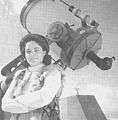 Dr. Shahla Solh-ju, Co-Director of Pahlavi University's Abu Reihan Observatory
Dr. Shahla Solh-ju, Co-Director of Pahlavi University's Abu Reihan Observatory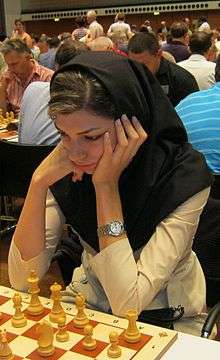 Atousa Pourkashiyan, chess player who holds the title of Woman Grandmaster
Atousa Pourkashiyan, chess player who holds the title of Woman Grandmaster Member of MRL robotics team at RoboCup
Member of MRL robotics team at RoboCup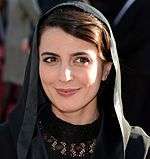 Leila Hatami, actress
Leila Hatami, actress An Iranian sportswoman in Olympic games 2016. Brazil, Rio de Janeiro
An Iranian sportswoman in Olympic games 2016. Brazil, Rio de Janeiro
See also
References
- ↑ "The Global Gender Gap Report 2013" (PDF). World Economic Forum. pp. 12–13.
- 1 2 CHN Press. "Women Held Power In Burnt City". Retrieved 2007-04-11.
- ↑ CHN Press. "Female population predominant in 5000-year-old Burnt City". Retrieved 2007-04-11.
- 1 2 3 Price, Massoume. "Women's Lives in Ancient Persia". Retrieved 2007-01-16.
- ↑ Harrison, Frances (September 22, 2005). "Polo comes back home to Iran". BBC News.
- ↑ Cotterell, Arthur (1998). From Aristotle to Zoroaster. New York: Free Press. p. 434. ISBN 0-684-85596-8. OCLC 39269485.
exercised by the Persian king's mother were set by the monarch himself
- ↑ Mackey, Sandra & Harrop, Scott (1996). The Iranians: Persia, Islam and the Soul of a Nation. Penguin. ISBN 0-452-27563-6. OCLC 38995082.
- ↑ Dodgeon M. H. & Lieu, S. N. C. (1991). The Roman Eastern Frontiers and the Persian Wars (AD 226–363); A Documentary History. London: Routledge. ISBN 0-415-10317-7. OCLC 29669928. pp. 24, 67, 184, 197, 307.
- ↑ Toward an aesthetic of Persian painting. Early Islamic Art, 650–1100. Oleg Grabar. pp. 213–214
- ↑ Women's Costume of the Near and Middle East. Jennifer M. Scarce. 2003, p. 134
- ↑ Robert Browning (1978). The Emperor Julian. University of California Press. p. 204. ISBN 0-520-03731-6. Retrieved 2010-10-27.
- 1 2 Pappé, Ilan (2005). The Modern Middle East. Routledge. p. 237. ISBN 0-415-21408-4.
- ↑ Wright, Robin B. (2000). The Last Great Revolution. p. 156. ISBN 978-0-375-40639-3.
- ↑ Curtis, Glenn E.; Hooglund, Eric (2008). Iran: A Country Study (PDF). Washington, DC:: Library of Congress, Federal Research Division. pp. 116–117. ISBN 9780844411873.
- ↑ Iran and the Surrounding World: Interactions in Culture and Cultural Politics. University of Washington Press. 2002. p. 206. ISBN 978-0295982069.
- ↑ "Adult education offers new opportunities and options to Iranian women". Ungei.org. 2006-03-06. Retrieved 2013-05-20.
- ↑ Bucar, Elizabeth M. Creative Conformity: The Feminist Politics of U.S. Catholic and Iranian Shi'i Women. Washington D.C.: Georgetown University Press, 2011.p. 35
- ↑ Bucar, Elizabeth M. Creative Conformity: The Feminist Politics of U.S. Catholic and Iranian Shi'i Women. Washington D.C.: Georgetown University Press, 2011. p. 37
- 1 2 "Iran - Literacy rate". indexmundi.com.
- ↑ "Iran, Islamic Rep.: Student enrollment, tertiary, female (WORLDBANK) - Data and Charts from Quandl". quandl.com. Archived from the original on October 27, 2014.
- 1 2 Statistical Centre of Iran (2011). Selected findings on 2011 Population and Housing Census. Teheran: Iranian ministry of the Interior, p. 35.
- ↑ Statistical Centre of Iran (2011). Selected findings on 2011 Population and Housing Census. Teheran: Iranian ministry of the Interior, p. 32.
- ↑ The Last Great Revolution by Robin Wright c. 2000, p. 137
- ↑ Ebadi, Shirin, Iran Awakening : A Memoir of Revolution and Hope by Shirin Ebadi with Azadeh Moaveni, Random House, 2006 (p. 210)
- ↑ Nature: News Feature
- ↑ "Iranian Democracy statistics - How Iran ranks". NationMaster. 2002-03-08. Retrieved 2013-05-20.
- ↑ "UNdata - record view - Seats held by women in national parliament, percentage". un.org.
- ↑ "شوراي عالي انقلاب فرهنگي - شورای فرهنگی اجتماعی زنان و خانواده - درباره شورا". iranwomen.org. Retrieved 2014-09-23.
- ↑ "In a decree issued by Dr. Mahmoud Ahmadinejad, Ms. Maryam Mojtahidzadeh has been appointed as the Advisor to the President and President of Center for Women and Family Affairs of IRAN". Women.gov.ir. 2009-12-15. Retrieved 2013-05-20.
- ↑ Kaplan, Robert, D. The Ends of the Earth, Random House, 1996, p. 181
- ↑ Women Police in Iran Archived May 22, 2007, at the Wayback Machine.
- ↑ Iran's thin black line Archived January 5, 2007, at the Wayback Machine.
- ↑ "Leader's Speech in Meeting with Woman Researchers of the Holy Quran". english.khamenei.ir. 20 October 2009. Retrieved 12 March 2016.
- ↑ Thomson Reuters Foundation. "Reuters Foundation Alertnet.org Iran". Alertnet.org. Retrieved 2013-05-20.
- ↑ Lorentz، J. Historical Dictionary of Iran. 1995. ISBN 0-8108-2994-0
- ↑ "رکورد جدید حضور زنان در مجلس ایران، پیام بزرگی دارد/ خواستار توسعه روابط با ایران هستیم" (in Persian). IRNA. 15 May 2016. Retrieved 26 May 2016.
- ↑ Will Fulton, Amir Toumajand Mary Ella Simmons (17 July 2013), "Iran News Round Up", Critical Threats, retrieved 25 August 2017
- ↑ Mohammadi, Elnaz (July 27, 2013). "حزب تشكيل دهيد، 50 نماينده در مجلس داشته باشيد". Bahar newspaper (in Persian). Tehran: 11. Archived from the original on October 18, 2013. Retrieved September 29, 2017.
- ↑ "Need For 'Positive Discrimination'", Financial Tribune, 14 December 2014, retrieved 25 August 2017
- ↑ "Iran's Rouhani names female VPs as reformists slam all-male ministers", Agence France-Presse, 10 August 2017, retrieved 25 August 2017 – via The Independent
- ↑ "Iranian women condemn "regressive" articles of family legislation", Radio Zamaneh, 27 August 2010, retrieved 25 August 2017
- ↑ Vakil, Sanam (2011). Women and Politics in the Islamic Republic of Iran: Action and Reaction. A & C Black. p. 85. ISBN 9781441197344.
- ↑ Sadr-ol-odabaee, Maryam; Hassan-Miri, Fahimeh (1 May 2013). "دبیر کل جمعیت حمایت از حقوق بشر زنان: می گویند زنان تجربه مدیریتی ندارند؛ این تجربه باید ازکجا شروع شود؟" (in Persian). Khabar Online. Retrieved 29 September 2017.
- 1 2 "Factfish Enrolment, engineering, manufacturing and construction, tertiary, female world statistics and data as Table". factfish.com. Archived from the original on 2014-08-05. Retrieved 2014-09-23.
- 1 2 Esfahani, Kouhi (2014). "Iranian Women: One Step Forward, Two Steps Back". Middle Eastern Studies / Ortadogu Etütleri. 5 (2): 36, 38, 39, 40.
- 1 2 Mehran, Golnar (2003-08-01). "The Paradox of Tradition and Modernity in Female Education in the Islamic Republic of Iran". Comparative Education Review. 47 (3): 269–286. doi:10.1086/378248. ISSN 0010-4086.
- ↑ Shavarini, Mitra K. (2005-01-01). "The Feminisation of Iranian Higher Education". International Review of Education / Internationale Zeitschrift für Erziehungswissenschaft / Revue Internationale de l'Education. 51 (4): 329–347, 331, 333, 334, 335. JSTOR 25054545.
- 1 2 3 4 5 Bahramitash, Roksana (Spring 2004). "Market fundamentalism versus religious fundamentalism: women's employment in Iran". Critique: Critical Middle Eastern Studies. Taylor & Francis. 13 (1): 33–46. doi:10.1080/1066992042000189706.
- 1 2 3 4 5 6 7 8 9 10 11 Olmsted, Jennifer C. (2011). "Gender and globalization: the Iranian experience". In Bahramitash, Roksana; Salehi Esfahani, Hadi. Veiled employment: Islamism and the political economy of women's employment in Iran. Syracuse, New York: Syracuse University Press. pp. 25–52. ISBN 9780815632139.
- ↑ "Girls to boys ratio, primary level enrolment statistics - countries compared". NationMaster. Retrieved 2013-05-20.
- 1 2 3 Afshar, Haleh (September 1997). "Women And work in Iran". Political Studies. Wiley. 45 (4): 755–767. doi:10.1111/1467-9248.00110.
- ↑ United Nations Development Programme
- ↑ "Law and women's agency in post-revolutionary Iran" (Pdf). Retrieved 20 May 2013.
- ↑ "Where are Iran's working women?". Payvand.com. Retrieved 20 May 2013.
- ↑ Mollahosseini, Ali (January 2008). "Gender and employment in Iran". Indian Journal of Gender Studies. Sage. 15 (1): 159–162. doi:10.1177/097152150701500110.
- ↑ (International Labour Organization).
- 1 2 Moghadam, Valentine M. (2004). "Women in the Islamic Republic of Iran: legal status, social positions, and collective action" (pdf). Wilsoncenter.org. Retrieved 20 September 2012.
- ↑ Ghorayshi, Parvin (Autumn 1996). "Women, paid-work and the family: in the Islamic Republic of Iran". Journal of Comparative Family Studies. University of Calgary via JSTOR. 27 (3): 453–466. JSTOR 41603457.
- 1 2 3 Bahramitash, Roksana (2003). "Revolution, Islamization, and women's employment in Iran". Brown Journal of World Affairs. Brown University. IX (2): 229–241. Pdf.
- ↑ Ali Akbar, Mahdi (2006), "Iranian women: between Islamicization and globalization", in Mohammadi, Ali, Iran encountering globalization: problems and prospects (PDF) (2nd ed.), London: Routledge, pp. 47–71, ISBN 9780415391788.
- 1 2 3 4 5 6 Karimi, Zahra (Autumn 2008). "International trade and employment in labour-intensive sectors in Iran: the case of carpet-weavers". Iranian Economic Review. EconLit. 13 (22): 41–68.
- ↑ Moafian, Abdolhamid, comp. Human Development Report of the Islamic Republic of Iran, 1999. Rep. no. 185. Trans. Ghodratollah Memarzadeh. N.p.: Plan and Budget Organization, n.d. UNDP. Web. 20 Sept. 2012. Pdf.
- ↑ Leila Piran. "Women and Entrepreneurship in Iran — Iran Startups". Medium.
- ↑ "Female Entrepreneurs Fuel A Changing Iran". worldcrunch.com.
- ↑ "Nikki R. Keddie, Social Research via findarticles.com". Summer 2000. Retrieved 2008-09-21.
- 1 2 3 4 5 6 7 8 9 10 Hoodfar, Homa (fall 1993). The Veil in Their Minds and On Our Heads: The Persistence of Colonial Images of Muslim Women, Resources for feminist research (RFR) / Documentation sur la recherche féministe (DRF), Vol. 22, n. 3/4, pp. 5–18, Toronto: Ontario Institute for Studies in Education of the University of Toronto (OISE), ISSN 0707-8412
- ↑ "Profile: Shirin Ebadi". article. BBC News. 27 November 2009.
- ↑ "IRANIAN SCIENCE: Iranian Women Hear the Call of Science". Science. 290: 1485. doi:10.1126/science.290.5496.1485. Retrieved 2014-09-23.
- ↑ Enrolment, tertiary, female (percent of total enrolment) - for all countries (FactFish per Worldbank)
- ↑ UN: Hold Ahmadinejad Accountable for Iran Rights Crisis, Human Rights Watch, September 18, 2008. Retrieved September 21, 2008.
- ↑ Iranian Dissidents at Forum Speak On Ahmadinejad, Women's Rights, New York Sun, Special to the Sun, October 17, 2007. Retrieved September 21, 2008.
- ↑ victory on marriage legislation, Borzou Daragahi, Los Angeles Times, September 3, 2008. Retrieved September 21, 2008.
- ↑ "BBC: "Iran backs first woman minister", September 3, 2009". BBC News. 2009-09-03. Retrieved 2013-05-20.
- ↑ "Iranians celebrate national Women's Day". Press TV. 30 March 2016. Retrieved 26 May 2016.
- 1 2 3 4 5 6 7 8 9 10 11 El Guindi, Fadwa (1999). Veil: Modesty, Privacy and Resistance, Oxford; New York: Berg Publishers; Bloomsbury Academic, pp. 3, 13–16, 130, 174–176, ISBN 9781859739242
- 1 2 Fathi, Asghar (1985). Women and the Family in Iran, Social, economic, and political studies of the Middle East, Vol. 38, Leiden: Brill, pp. 7, 57, 61–62, 107–109, ISBN 9789004074262
- ↑ Scarce, Jennifer M. (1975). The Development of Women's Veils in Persia and Afghanistan, Costume, Journal of the Costume Society, Vol. 9. (1), Leeds: Maney Publishing, p. 4, ISSN 0590-8876
- ↑ Peck, Elsie H. (1992). "Clothing viii. In Persia from the Arab conquest to the Mongol invasion", in Yarshater, Ehsan: Encyclopædia Iranica, Vol. V, Fasc. 7, pp. 760–778, Costa Mesa: Mazda Publishers, ISBN 9780939214792
- 1 2 3 4 5 6 Heath, Jennifer (2008). The Veil: Women Writers on Its History, Lore, and Politics, Berkeley; Los Angeles: University of California Press, pp. 66, 252–253, 256, 260, ISBN 9780520255180
- 1 2 Keddie, Nikki R. (2005). "2. The past and present of women in the Muslim world" in Moghissi, Haideh: Women and Islam: Images and realities, Vol. 1, pp. 53–79, Abingdon, Oxon; New York: Routledge; Taylor & Francis, ISBN 9780415324199
- ↑ Mitchell, Colin P. (2011). New Perspectives on Safavid Iran: Empire and Society, Abingdon, Oxon; New York: Taylor & Francis, pp. 98–99, 104, ISBN 9780415774628
- 1 2 Floor, Willem M. (2003). Agriculture in Qajar Iran, Washington, DC: Mage Publishers, pp. 113, 268, ISBN 9780934211789
- 1 2 3 4 Chehabi, Houchang Esfandiar (2003): "11. The Banning of the Veil and Its Consequences" in Cronin, Stephanie: The Making of Modern Iran: State and Society under Riza Shah, 1921–1941, pp. 203–221, London; New York: Routledge; Taylor & Francis, ISBN 9780415302845
- 1 2 Bullock, Katherine (2002). Rethinking Muslim Women and the Veil: Challenging Historical & Modern Stereotypes, Herndon, Virginia; London: International Institute of Islamic Thought, pp. 90–91, ISBN 9781565642874
- 1 2 3 4 5 6 7 8 9 10 11 Milani, Farzaneh (1992). Veils and Words: The Emerging Voices of Iranian Women Writers, Syracuse, New York: Syracuse University Press, pp. 19, 34–37, ISBN 9780815602668
- 1 2 3 4 5 6 7 8 Paidar, Parvin (1995): Women and the Political Process in Twentieth-Century Iran, Cambridge Middle East studies, Vol. 1, Cambridge, UK; New York: Cambridge University Press, pp. 106–107, 214–215, 218–220, ISBN 9780521473408
- ↑ Majd, Mohammad Gholi (2001). Great Britain and Reza Shah: The Plunder of Iran, 1921–1941, Gainesville: University Press of Florida, pp. 209–13, 217–218, ISBN 9780813021119
- 1 2 Curtis, Glenn E.; Hooglund, Eric (2008). Iran: A Country Study, 5th ed, Area handbook series, Washington, DC: Federal Research Division, Library of Congress, pp. 28, 116–117, ISBN 9780844411873
- 1 2 3 4 5 Katouzian, Homa (2003). "2. Riza Shah's Political Legitimacy and Social Base, 1921–1941" in Cronin, Stephanie: The Making of Modern Iran: State and Society under Riza Shah, 1921–1941, pp. 15–37, London; New York: Routledge; Taylor & Francis, ISBN 9780415302845
- 1 2 3 4 5 Katouzian, Homa (2004). "1. State and Society under Reza Shah" in Atabaki, Touraj; Zürcher, Erik-Jan: Men of Order: Authoritarian Modernisation in Turkey and Iran, 1918–1942, pp. 13–43, London; New York: I.B. Tauris, ISBN 9781860644269
- 1 2 3 4 5 Katouzian, Homa (2006). State and Society in Iran: The Eclipse of the Qajars and the Emergence of the Pahlavis, 2nd ed, Library of modern Middle East studies, Vol. 28, London; New York: I.B. Tauris, pp. 33–34, 335–336, ISBN 9781845112721
- ↑ Fatemi, Nasrallah Saifpour (1989). Reza Shah wa koudeta-ye 1299 (Persian), Rahavard – A Persian Journal of Iranian Studies, Vol. 7, n. 23, pp. 160–180, Los Angeles: Society of the Friends of the Persian Culture, ISSN 0742-8014
- 1 2 3 4 5 6 Beeman, William Orman (2008). The Great Satan vs. the Mad Mullahs: How the United States and Iran Demonize Each Other, 2nd ed, Chicago: University of Chicago Press, pp. 108, 152, ISBN 9780226041476
- 1 2 3 Ramezani, Reza (2008). Hijab dar Iran, dar doure-ye Pahlavi-ye dovvom [Hijab in Iran, the second Pahlavi era] (Persian), Faslnamah-e Takhassusi-ye Banuvan-e Shi’ah [Quarterly Journal of Shiite Women], Qom: Muassasah-e Shi’ah Shinasi, ISSN 1735-4730
- 1 2 Gheiby, Bijan; Russell, James R.; Algar, Hamid (1990). "Čādor (2)" in Yarshater, Ehsan: Encyclopædia Iranica, Vol. IV, Fasc. 6, pp. 609–611, London; New York: Routledge & Kegan Paul, ISBN 9780710091321
- 1 2 3 4 5 6 Ramezani, Reza (spring 2007). Hijab dar Iran az Enqelab-e Eslami ta payan Jang-e Tahmili [Hijab in Iran from the Islamic Revolution to the end of the Imposed war] (Persian), Faslnamah-e Takhassusi-ye Banuvan-e Shi’ah [Quarterly Journal of Shiite Women] 11, Qom: Muassasah-e Shi’ah Shinasi, pp. 251-300, ISSN 1735-4730
- ↑ AP (2017-12-28). "Women will no longer be arrested for flouting dress code: Tehran police". DAWN.COM. Retrieved 2017-12-28.
- ↑ "Tehran police: No more arrests for flouting dress code". Fox News. 2017-12-28. Retrieved 2017-12-28.
- ↑ "Women in Tehran will no longer face arrest for flouting dress code, say police - Independent.ie". Independent.ie. Retrieved 2017-12-28.
- ↑ "The international symposium on Simin Behbahani". Iranianstudies.ca. Retrieved 2013-05-20.
- ↑ Golbarg Bashi (November 25, 2005). "Feminist Ink". Feminist Ink. iranian.com. Archived from the original on 2007-11-11. Retrieved 2007-11-18.
- ↑ "Haus der Kulturen der Welt". Archiv.hkw.de. Retrieved 2013-05-20.
- ↑ Brosius, Maria. Women in Ancient Persia, 559–331 B.C. Oxford Classical Monographs. Oxford University Press (UK), 1998.
Further reading
- Persian Women & Their Ways Clara Colliver Rice. 1923. Seeley, Service & Co.
- Voices from Iran: The Changing Lives of Iranian Women. Mahnaz Kousha. Syracuse University Press. 2002.
- Veils and Words: The Emerging Voices of Iranian Women Writers. Farzaneh Milani. Published 1992 by I.B.Tauris
- Piyrnia, Mansoureh. Salar Zanana Iran. 1995. Maryland: Mehran Iran Publishing.
- Brosius, Maria. Women in Ancient Persia, 559–331 B.C. Oxford Classical Monographs. Oxford University Press (UK), 1998.
- Farman Farmaian, Sattareh. 1992. Daughter of Persia: A Woman's Journey from Her Father's Harem Through the Islamic Revolution. New York: Three Rivers Press.
- Najmeh Khalili Mahani, Women of Iranian Popular Cinema: Projection of Progress, Offscreen, Vol. 10, Issue 7, July 31, 2006, .
External links
| Wikimedia Commons has media related to Women of Iran. |
- IranDokht' – A comprehensive portal and magazine
- Iran Electoral Archive – Women in Politics
- Iranian Women Resources
- Qajar Women Archive, a digital archive of primary-source materials related to the lives of women during the Qajar era (1786 - 1925) in Iran. The Harvard University Library (HUL) central infrastructure accommodates and catalogs the archive.
- WOMEN’S EDUCATION IN THE QAJAR PERIOD, Encyclopædia Iranica
- WOMEN’S EDUCATION IN THE PAHLAVI PERIOD AND AFTER, Encyclopædia Iranica
- Women of IRAN', Social Documentary photos of Behrouz Reshad
- History of Iranian Photography. Women as Photography Model: Qajar Period, photographs provided by Bahman Jalali, Iranian Artists' site, Kargah
- Videos
- Role and status of women in the Iranian society – PressTV (2012)
- Women and Islamic Awakening – PressTV (2012)
